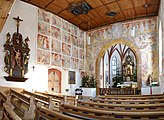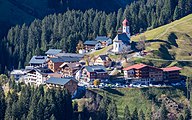You can help expand this article with text translated from the corresponding article in German. Click for important translation instructions.
|
| Damüls | |
|---|---|
| Municipality | |
 | |
 Coat of arms Coat of arms | |
 Location in the district Location in the district | |
 | |
| Coordinates: 47°17′N 09°53′E / 47.283°N 9.883°E / 47.283; 9.883 | |
| Country | Austria |
| State | Vorarlberg |
| District | Bregenz |
| Government | |
| • Mayor | Stefan Bischof |
| Area | |
| • Total | 20.91 km (8.07 sq mi) |
| Elevation | 1.428 m (4.685 ft) |
| Population | |
| • Total | 313 |
| • Density | 15/km (39/sq mi) |
| Time zone | UTC+1 (CET) |
| • Summer (DST) | UTC+2 (CEST) |
| Postal code | 6884 |
| Website | http://www.damuels.at/ |
Damüls (Alemannic German: Dimülsch) is a village community and popular tourist resort in the district of Bregenz in the westernmost Austrian state of Vorarlberg.
Damüls is known for its abundance of snow. In 2006, Damüls was awarded the honorary title "the snowiest village in the world".
Population
| Year | Pop. | ±% |
|---|---|---|
| 1869 | 383 | — |
| 1880 | 365 | −4.7% |
| 1890 | 278 | −23.8% |
| 1900 | 241 | −13.3% |
| 1910 | 225 | −6.6% |
| 1923 | 204 | −9.3% |
| 1934 | 218 | +6.9% |
| 1939 | 209 | −4.1% |
| 1951 | 223 | +6.7% |
| 1961 | 241 | +8.1% |
| 1971 | 322 | +33.6% |
| 1981 | 304 | −5.6% |
| 1991 | 309 | +1.6% |
| 2001 | 326 | +5.5% |
| 2011 | 316 | −3.1% |
Geography
Damüls is situated at an altitude of 1,430 m. It has an area of 20.92 km². It borders on the Bregenz Forest, the Biosphere Reserve Großes Walsertal, the Laternsertal, and all other Vorarlberg districts (Bludenz, Feldkirch and Dornbirn). The most famous mountain peak in the area, a popular hiking destination from Damüls, is the Damülser Mittagsspitze (2,095 m).
History
In the late Middle Ages c. 1300, the Walser ethnic folk group fled from the Swiss Kanton Wallis to this area seeking a better way of life and agricultural land. They were allowed to settle in Vorarlberg (then largely under the Swabian Counts of Mountfort), in the west of Tyrol and in Graubünden. From 1313 onwards, Damüls was populated by Walsers. At the time, the Supreme Court (Damüls and Fontanella) was independent. The inhabitants of Damüls, in return, joined the Montfort House to serve with "spear and shield" in the event of war.
Culture
The Vorarlberger FIS Skimuseum Damüls offers exhibitions on the long history of skiing in Vorarlberg. In addition to historic and rare Alpine skis, ski jump-related objects are also on display. The entry is free.
The Church of St. Nikolaus occupies a prominent place in the mountain village of Damüls. The art-historically valuable church with its preserved frescoes depicting a Bible for the poor dates from the time of the arrival of the Walsers in the 13th/14th centuries.
Customs
In the region, many old traditions are still alive and well, including the typical dialect that is still spoken here. Wearing traditional folk costumes ("tracht") on festive occasions also contributes to an authentic yesteryear atmosphere. Alpine Transhumance, or mobile mountain meadow culture, is still practiced in Damüls. This means that farmers bring their cattle to wherever food is available in the mountains. Depending on the season, cattle will change stables several times a year. Alpine transhumance is also called "Dreistufenwirtschaft" (literally "three stage economy") in German because the mountain pastures are managed in three stages: lower, middle, and upper mountain altitudes. This transhumance is one of the prime factors preserving the natural and cultural landscape of the region, along with the strong tradition of cheese production in Vorarlberg. In 2011, the UNESCO declared the "Dreistufenwirtschaft" in the Bregenz Forest to be an intangible cultural heritage.
Tourism
Thanks to the merging of the two ski areas of Damüls and Mellau in 2010, the largest ski area in the Bregenz Forest, and one of the largest ski regions in the state of Vorarlberg, was created: the ski area Damüls-Mellau. There is a 2.5 km long natural toboggan run which is illuminated two days a week.
This resort region is known for its abundance of snow. In 2006, Damüls was awarded the title "Snowiest village in the world". On average, there is 9.30 meters of fresh snow per season.
Numerous hiking trails lead from Damüls over alpine meadows and to summits with views over the surrounding mountain tops. The temperatures are pleasant even during hot periods in midsummer.
See also
Photo gallery
-
 Church St. Nikolaus in the winter
Church St. Nikolaus in the winter
-
 Frescoes in the Church St. Nikolaus
Frescoes in the Church St. Nikolaus
-
 Inside the FIS Skimuseum Damüls
Inside the FIS Skimuseum Damüls
-
 The ski area Damüls-Mellau
The ski area Damüls-Mellau
-
 A snowboarder in the ski area Damüls-Mellau
A snowboarder in the ski area Damüls-Mellau
-
 View of the Damülser Mittagsspitze and the ski area of Damüls-Mellau
View of the Damülser Mittagsspitze and the ski area of Damüls-Mellau
-
 The centrum of Damüls
The centrum of Damüls
-
Damüls in the summer time
References
- "Dauersiedlungsraum der Gemeinden Politischen Bezirke und Bundesländer - Gebietsstand 1.1.2018". Statistics Austria. Retrieved 10 March 2019.
- "Einwohnerzahl 1.1.2018 nach Gemeinden mit Status, Gebietsstand 1.1.2018". Statistics Austria. Retrieved 9 March 2019.
- "Damüls". Bregenzerwald in Vorarlberg (in German). Retrieved 2022-08-19.
- ^ "Skigebiet Damüls-Mellau und Faschina | Damüls Faschina Tourismus". www.damuels.at (in German). Retrieved 2022-08-19.
- "Das schneereichste Dorf der Welt". www.schneehoehen.at. Retrieved 2022-08-19.
- "Damüls". Bregenzerwald in Vorarlberg (in German). Retrieved 2022-08-19.
- "Das Dorf Damüls | Die Dörfer | REGION". damuels.travel. Retrieved 2018-08-16.
- "FIS Skimuseum Damüls". Urlaub in Vorarlberg (in German). 2022-02-25. Retrieved 2022-08-19.
- "Damüls". Bregenzerwald in Vorarlberg (in German). Retrieved 2022-08-19.
- "Brauchtum & Tradition | Damüls Faschina Tourismus". www.damuels.at (in German). Retrieved 2022-08-19.
- "Österreichische UNESCO-Kommission - Nationalagentur für das Immaterielle Kulturerbe - Österreichisches Verzeichnis". 2014-04-09. Archived from the original on 2014-04-09. Retrieved 2022-08-19.
- "Damüls". Bregenzerwald in Vorarlberg (in German). Retrieved 2022-08-19.
- "Das schneereichste Dorf der Welt". www.schneehoehen.at. Retrieved 2022-08-19.
- "Damüls". Bregenzerwald in Vorarlberg (in German). Retrieved 2022-08-19.